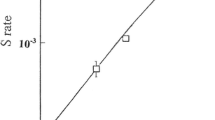Summary
Evidence for diploidy at loci located all around the Bacillus subtilis chromosome previously led us to refer to the prototrophic bacterial clones produced by fusion of polyauxotrophic protoplasts as complementing diploid clones (Lévi-Meyrueis et al. 1980; Sanchez-Rivas 1982). In this paper, evidence is presented that gene inactivation may occur in such clones, as judged from the unequal expression of three unselected markers and their low transforming activity in cell lysates, an established property of inactivated genes (Bohin et al. 1982). The insensitivity to protease treatment of the lysates and also the low transforming activity observed with purified DNA may indicate that chromosome inactivation does not necessarily result from the mere attachment of proteins to DNA. Cotransfer by transformation of similarly expressed genes, initially located on separate chromosomes, suggests that genetic recombination has taken place, resulting in the reassortment of active and inactive genes on separate chromosomes. Several genetic structures compatible with the observations are presented which illustrate that prototrophy may result from such reassortment as well as from functional complementation.
Similar content being viewed by others
References
Aharonowitz Y, Ron Ez (1970) Transformation in Bacillus subtilis. A simple direct method. Mol Gen Genet 107:94–96
Bettinger GE, Young FE (1975) Transformation of Bacillus subtilis: transforming ability of deoxyribonucleic acid in lysates of L-forms or protoplasts. J Bacteriol 122:987–993
Bohin JP, Ben Khalifa K, Guillen N, Schaeffer P, Hirschbein L (1982) Phenotypic expression in vivo and transforming activity in vitro: two related functions of folded bacterial chromosomes. Mol Gen Genet 185:65–68
Fournier P, Provost A, Bourguignon C, Heslot H (1977) Recombination after protoplast fusion in the yeast Candida tropicalis. Arch Microbiol 115:143–149
Guillen N, Gabor MH, Hotchkiss RD, Hirschbein L (1982) Isolation and characterization of the nucleotid of non-complementing diploids from protoplast fusion in Bacillus subtillis. Mol Gen Genet 185:69–74
Henner DJ, Hoch JA (1980) The Bacillus subtilis chromosome. Microb Rev 44:57–82
Hotchkiss RD, Gabor MH (1980) Biparental products of bacterial protoplast fusion showing unequal parental chromosome expression. Proc Natl Acad Sci USA 77:3553–3557
Ionesco H, Michel J, Cami B, Schaeffer P (1970) Genetics of sporulation in Bacillus subtilis Marburg. J Appl Bacteriol 33:13–24
Karmazyn C, Anagnostopoulos C, Schaeffer P (1972) Dominance of spoOA mutations in spo +/spo merodiploid strains of Bacillus subtilis. In: Haivorson HO, Hanson R, Campbell LL (eds) Spores V. Am Soc Microbiol, Washington DC, pp 126–132
Lévi C, Sanchez-Rivas C, Schaeffer P (1977) Further genetic studies on the fusion of bacterial protoplasts. FEMS Microbiol Lett 2:323–326
Lévi-Meyrueis C, Sanchez-Rivas C, Schaeffer P (1980) Formation de bactéries diploïdes stables par fusion de protoplastes de Bacillus subtilis et effet de mutations rec sur les produits de fusion formés. CR Seances Acad Sci Paris D 291:67–70
Liskay RM, Evans RJ (1980) Imactive X chromosome DNA does not function in DNA-mediated cell transformation for the hypoxanthine phosphoribosyltransferase gene. Proc Natl Acad Sci USA 77:4895–4898
Lyon MF (1968) Chromosomal and subchromosomal inactivation. Annu Rev Genet 2:31–52
Mohandas T, Sparkes RS, Shapiro LJ (1981) Reactivation of an inactive human X chromosome: evidence for X inactivation by DNA methylation. Science 211:393–396
Sanchez-Rivas C (1982) Direct selection of complementing diploids from PEG-induced fusion of Bacillus subtilis protoplasts. Mol Gen Genet 185:329–333
Sanchez-Rivas C, Lévi-Meyrueis C, Lazard-Monier F, Schaeffer P (1982) Diploid state of phenotypically recombinant progeny arising after protoplast fusion in Bacillus subtilis. Mol Gen Genet 188:272–278
Sanchez-Rivas C, Bohin JP (1983) Cardiolipin content and protoplast fusion efficiency in B. subtilis. FEMS Microbiol Lett 19:137–141
Schaeffer P, Cami B, Hotchkiss RD (1976) Fusion of bacterial protoplasts. Proc Natl Acad Sci USA 77:2151–2155
Sonenshein AL, Cami B, Brevet J, Cote R (1974) Isolation and characterization of rifampicin-resistant and streptolydigin-resistant mutants of Bacillus subtilis with altered sporulation properties. J Bacteriol 120:253–265
Venolia L, Gartler SM (1983) Comparison of transformation efficiency of human active and inactive X-chromosomal DNA. Nature 302:82–83
Author information
Authors and Affiliations
Additional information
Communicated by K. Isono
Associated to the C.N.R.S. (L.A.n0136)
Rights and permissions
About this article
Cite this article
Lévi-Meyrueis, C., Sanchez-Rivas, C. Complementation and genetic inactivation: Two alternative mechanisms leading to prototrophy in diploid bacterial clones. Molec. Gen. Genet. 196, 488–493 (1984). https://doi.org/10.1007/BF00436197
Received:
Issue Date:
DOI: https://doi.org/10.1007/BF00436197




